Brand marketing and Product marketing — why should these two things be aligned, linked, and synced permanently?
You can find dozens of explanations and definitions for product and brand marketing. But I will give you some advice on how to align them.
It’s 100% based on my own working experience. Working at ClickMeeting, I manage brand communication strategy and product marketing.
Nominally, I am a brand manager, but in reality, I also deal with implementing brand strategy at the product level.
Why? Because there is no product marketing manager in our marketing team. It’s about something other than job titles, especially in the marketing departments of smaller companies. It is more important to know that there must be a link between brand strategy and product communication, as well as when and what questions to ask.
Have you ever asked yourself these questions? If you did, you are both a brand manager and product marketing manager:
1. Do I know why my company exists?
2. Do I know what its purpose is besides making a profit?
3. Do you know who and why you should listen to your company?
4. And when someone eventually does, will it change anything?
5. Will it help anybody when they use your product or service?
Questions 1 and 2 — a brand manager knows the answers.
Questions 3 — a brand manager and product manager should meet at a cafe and talk about possible answers
Questions 4 and 5 — a product marketing manager knows the answers.
How to align those two areas? Let’s find out together. No bullshit. Only real insights.
What is Brand Marketing
Let’s start with the definition and core components of brand marketing:
This is the kind of marketing where you are willing to explain why it’s worth investing your limited resources in developing a brand instead of spending all the money on product demos, lead generation, and sales campaigns.
A brand that doesn’t have physical evidence of existence until you put a graphic representation of it on a product package or a company website.
This kind of marketing can often involve convincing the company owner you work for about the value of investing in brand awareness campaigns.
This approach is different from simply asking people to buy your product immediately.
Even 15 times a day, depending on the capping you set in your remarketing campaigns. Instead, the goal is to make people from your target group believe you have something meaningful to say.
How Brand Identity Shapes a Standout Image
We live in a world of similar products and services. It’s easier than ever to copy someone’s product, feature, design, or even the whole service.
That’s why now, more than ever, we need to create a recognizable brand with a distinctive image. A brand that has something to say and something in common with people who might be your potential customers.
Show them what you, as a brand, care about. What are the values you stand for? Show your customers who you are and who you as a brand will never be.
The product or service you put the brand name on can’t be for everyone. If you produce outdoor equipment for people who love the natural environment, your brand has to go green, too. And it has to have a 100% plausible attitude.
So it’s not enough to declare “we love nature.” Your production lines have to be sustainable and eco-friendly, too. If you care about the planet and CO2 emissions, as Bill Gates admits almost every day, you cannot fly by private jet all over the world at the same time. The CEO of your company cannot be like Bill 😀
Suppose your brand is all about products for blue-collar workers who like living traditionally. In that case, you cannot say that your product is also for people who identify with the LGBTQIA movement, especially when it comes to beer. The Bud Light crisis is the latest example of what kind of damage it can cause.
If you’re unfamiliar with that case, check out this LinkedIn post from Patrick Campbell (the founder of Profitwell and the CSO of Paddle).
Defining Brand Principles and Market Positioning
You might think that building a recognizable brand is too time-consuming and costly. You might be tempted to copy your main competitors, buy fake reviews, and focus on creating a product or service with the same features for less with better customer support.
But that’s short-sighted and risky. You must differentiate yourself from the crowd and build customer trust and loyalty.
Your goal is to create a brand that resonates with your target group and reflects their values. You might think that your main goal is to make a profit in the first place, but you don’t need to say that in your communication. It’s obvious, and your customers don’t care. They care about how your product will benefit them and what value proposition you offer.
So, let’s stick to this.
Even if your strategy is to follow the leader, you must tell your customers why they should choose you. Avis did this in their famous campaign, where they admitted they were a smaller car rental company than Hertz, so they always “Try harder.”
But remember, the value proposition has to match your brand values. You want your product and brand to be consistent. For example, if you run an eco-friendly company, you must tell your customers that your outdoor clothes are not only good for the planet.
You also need to tell them how your clothes can keep them warm and dry on long hikes and how they can feel comfortable on their skin because of the natural fabrics you use. That’s an excellent value for them.
Building Emotional Connections with Customers through Storytelling
If you have just started your company, tell them why you did that. But don’t just say that you wanted to be a successful manager, earn a lot of money, or were inspired by Bill Gates, Jeff Bezos, or Steve Jobs.
Tell your own story, the true story, YOUR story.
Let’s go back to the example of the outdoor clothing company. Let’s say you always loved hiking, even in severe weather conditions, during downpours, freezing temperatures, and in the scorching sun of Patagonia.
But your problem was your skin’s allergic reaction to synthetic fabrics and chemical substances added to the outdoor and sports clothing.
You wanted to do something about it and created your allergen-free sports clothing. And you did it without compromising the protection functions. You tested it on yourself and on your oldest child, who is allergic, too. It worked perfectly for both of you. No allergic reactions, but still wind and waterproof. First, you started making it just for your close family, then for your friends from work, and then…
That’s your story!
Just write about it, record a video, publish it on your social media profiles under your real name, and put it in the “about us” section on your company’s website. Let your current and potential customers read about it.
Let them know that you are not just the owner but an inventor in the first place who wanted to help other people who had a similar problem to yours. Now you are giving them a reason to like you as a human being, a father, not just a successful manager.
You are giving them a reason to like your brand. To create a human-like bond. Not just a transactional relationship.
Engaging Brand Ambassadors and Influencers for Authentic Promotion
So if your company is successful, if you are helping your customers and they are ready to give a shout-out, let them speak. Let them share their stories with you and the other customers.
Go and meet them and visit their homes and jobs. And if it’s not possible because they don’t have time or the distance is too big, set up an online meeting. Publish the video recording and write a summary of it. Write a case study. Build a whole community around the brand and the values you and your loyal customers mutually care about.
Oh, I almost forgot one more thing. You can also give them a seasonal discount, but you don’t have to… because they love your brand.
Brand marketing is all about creating a connection between your company and your customers. It’s about making them feel like they know, love, and share values with you. It’s about making them loyal to your brand, even if it means paying more for a simple t-shirt just because it has your logo.
How do I know that brand marketing works? Well, I’m writing this article in the summertime. And I can’t help but notice that there is only one kind of t-shirt that everyone seems to be wearing here in Poland: Tommy Hilfiger t-shirt.
OK, this is not a very objective or scientific observation, but I have some data to back it up. According to a survey by Real Research, 55.8% of the respondents said they prefer branded products over unbranded products (44.2%). That means more than half of the people are willing to pay extra for a brand name. (Source)
That’s the power of brand marketing! Use it wisely!
And Now Let’s Switch to Product Marketing
What the Hell is Product Marketing?
I won’t bore you with a long list of product marketing definitions or drown you in marketing jargon.
Instead, let’s start with one essential statement: most people don’t know much about your product and are overwhelmed by the number of alternatives and features available on the market.
They struggle to choose and purchase a product or service, even when considering buying something fancy, like a luxurious trip. It’s still painful for them. The exception is your competitors or experts like you, who don’t need your help.
You are the expert; you have the expertise. Look at your product and services from the perspective your customers have and give them the knowledge they need and lack to decide and solve their problem with your product.
So, the primary goal of product marketing is to help most people who are hesitant to buy because they’re unsure if the product is right for them, will work, or is overpriced. That’s why people dislike buying things these days and why it’s so important to remember that.
If you don’t believe me, it’s okay. But you’d better listen to April Duford.
Ok, let’s go back to the definition then
So, what exactly is product marketing? The best way to understand it is by looking at what it aims to achieve and what it does to get there.
Some of the main goals and tasks of product marketing are:
- Positioning and differentiation
- Messaging
- Market and competition research
- Product launch
- Product demos
- Onboarding & trainings
- Pricing & Packaging
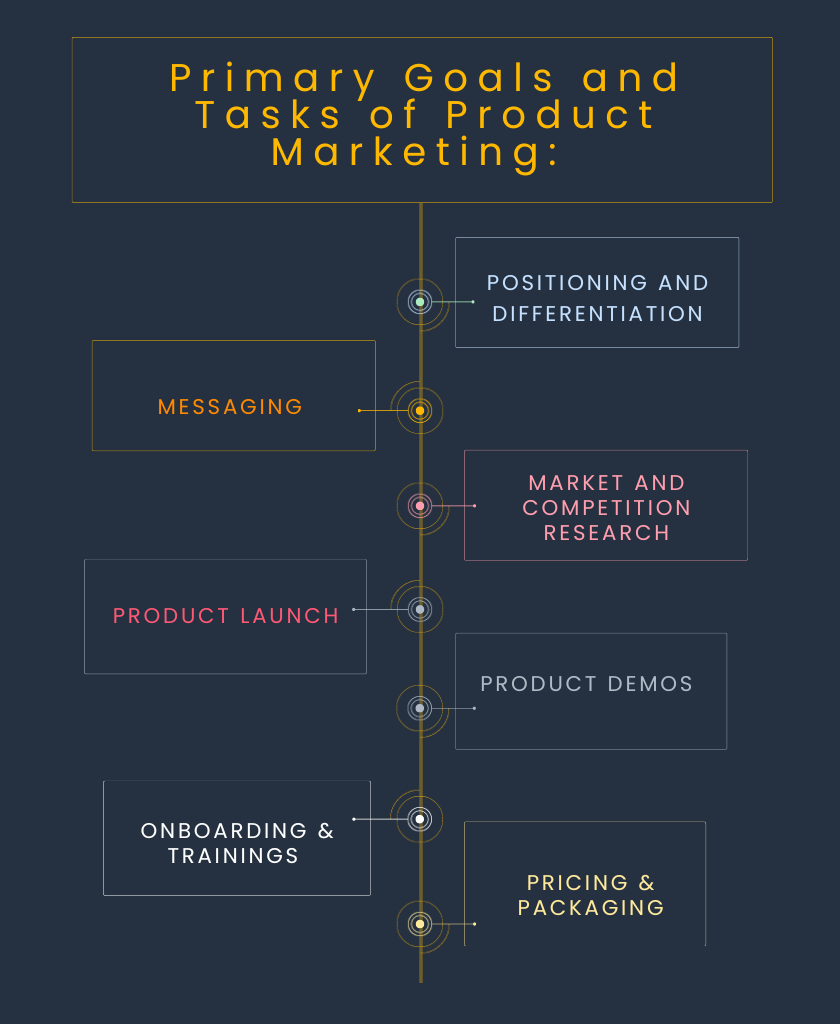
As the picture shows, product marketing connects four areas: product development, customer success, sales, and marketing.
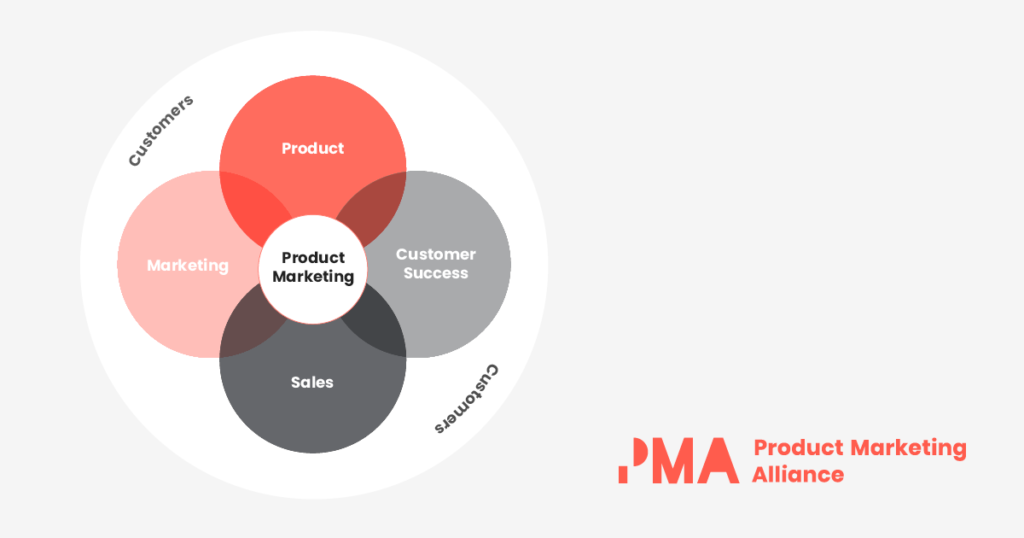
Product marketing is the glue that holds together product development, customer success, sales, and marketing.
It’s all about ensuring customers have the information they need to buy and use your product successfully before and after purchase.
To do this well, you need to keep those four areas talking to each other and sharing information.
If they’re siloed off, it’s like trying to run a business with one hand tied behind your back. It’s just not going to work as well as it could.

Product marketing is all about figuring out what your customers want and building a product that gives it to them.
You do that by doing market research and surveys.
Your marketing team, led by an analyst, does the market research.
Once you know who your potential customers are and where they are, you need to get the word out. You need to share what you know about your product and how it can benefit them.
By connecting the dots between product, marketing, sales, and customer service, you can create a message that speaks to your target audience.
If you do product marketing right, your product’s features will match what customers want, and your marketing messages will make that clear.
Customers will see your product or service as a solution to their problem, a way to improve their lives, and your brand as a guarantee that they’ll get what they paid for. That’s positioning. And that’s the place where product marketing and brand marketing finally met!
I can hear you laughing now, saying that this is all ridiculously obvious, and you knew it all before you read a word of this.
And you’re right.
But there’s a trap
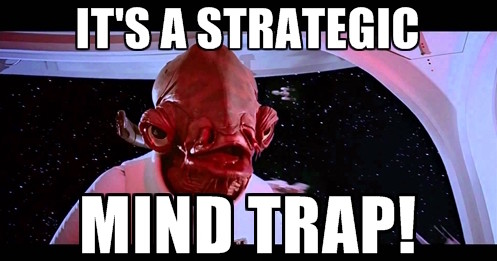
So many marketing managers think communicating value propositions is so easy and obvious that they forget to do this or don’t understand what it is.
Sometimes, they even talk about their own company profits instead of customer benefits.
They boast about their financial results, awards, and certificates.
And last but not least… THE LONG LIST OF FEATURES APPROACH!
Here is the long list of features. You decide what is best for you! Go through the list of 999 technical features and choose your best plan or product.
There’s a better way to do this
Don’t make customers go through a long list of features.
Why?
Because you’ve done your homework, you know how hard it is to choose for them and buy something. You want to make it easier and give them all the necessary information.
You know what you’re selling and who you’re selling it to. For example, you know it’s a family car, so your product message should show them how kid-friendly and spacious it is.
Now, as a product marketer, you need to be confident and honest with your customers.
You need to tell them that this car is designed for safe driving, not for speed. They are wasting their time here if they are looking for a car to race on the streets. They should come back when they grow up and have a family of their own.
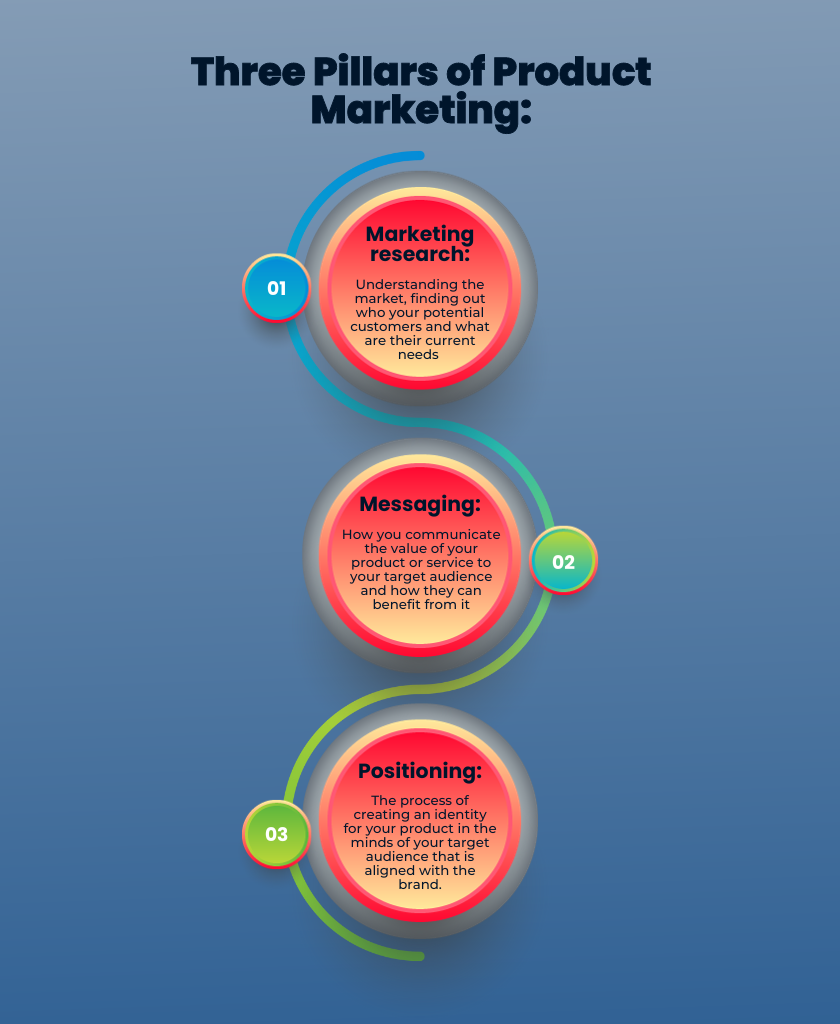
I dare a statement that product marketing is built on three pillars:
- Marketing research: understanding the market, finding out who your potential customers and what are their current needs
- Messaging: How you communicate the value of your product or service to your target audience and how they can benefit from it. The language that is 100% understandable to your customers
- Positioning: The process of creating an image or identity for your product or service in the minds of your target audience that is aligned with the brand. You have to decide what and who your product is for in the first place.
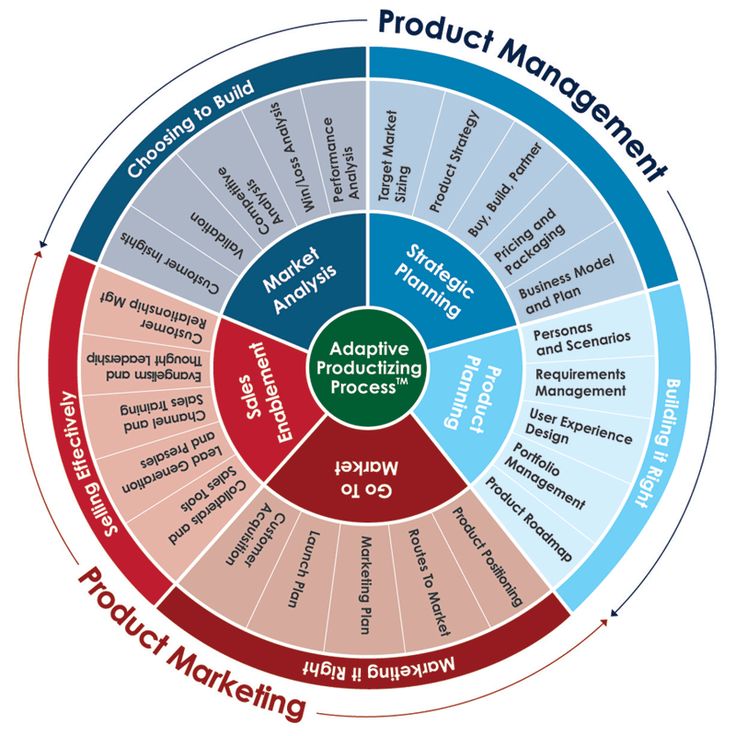
*Source – Product Marketing Alliance
Market Research and Customer Segmentation are a Must. Here’s Why:
You’re probably thinking, „Market research? I don’t have time and money for this!”
But trust me, you don’t want to waste your time on endless meetings arguing about who your target group is, what they value most in your product, and what kind of messaging will make them buy.
Even if you have a small business, you’ve probably already done some market research without realizing it.
For example, the company’s owner, who produces non-allergic outdoor clothing, did his research and realized that he wasn’t the only one with this problem.
He talked to other people with allergies, read about it online, and joined social media groups. He even hosted a webinar to learn more about what people were looking for in a product like his.
And another thing: how do you know if someone else isn’t offering the same thing as you, using the same messaging? How will you differentiate your product if you don’t do regular competitive analysis?
If you skip market research, you risk offering people too many choices. Too many features, too many products for everyone. It’s like trying to please everyone, but you end up pleasing no one.
Just because your product has a lot of features doesn’t mean you should offer them all to everyone. That’s an overkill and will only make it harder for people to choose your product. The more choices people have, the less likely they are to make a decision.
Research, research, research!
Successful companies take their time to:
- research,
- analyze,
- and debate what value propositions will resonate with their audience.
They use various methods such as:
- surveys,
- focus groups,
- interviews,
- and social media monitoring to gather customer insights and feedback.
By doing so, they can create a product that meets the customers’ needs and expectations while differentiating themselves from the competition. So don’t skip market research – it’s worth the investment!
Instead of overwhelming your customers with a long list of features, it’s better to do market research to find out what your target audience wants, who they are, and how and where they live. It might take a bit longer, but it’s worth it because it is more effective.
For instance, let’s say you’re selling bathroom equipment. You might have everything from washbasins, bathtubs, tiles, showers, and faucets. Your brand claim could be “Everything you need for your bathroom.” But that’s too broad. Instead, try targeting specific groups of customers.
For example, you could analyze the differences between your B2C and B2B customers. A couple from Ohio probably doesn’t need a steel urinal, but a gas station owner might. If you’re targeting a segment of people with small bathrooms, don’t show them pictures of huge bathrooms with fancy designer equipment.
*Source – Unsplash
That’s a B2B bathroom, for sure. You wouldn’t like to have these urinals in your bathroom at home 😉
Time for the segmentation
So, you’re curious about how to segment your customers? Well, there are many ways to do it, depending on their common interests.
- Demographics: One approach is to group them by demographics, such as age, gender, income, education, job title, marital status, and family size.
- Psychographics: Another method is to group them by psychographics, which includes their interests, values, lifestyle, and personality traits.
- Behavior: You can also categorize them by their behavior, like what they’ve purchased from you in the past, how they interact with your website, and how they engage with you on social media.
- Geography: You can group your customers by country, region, city, or ZIP code.
- Problems and Needs: You can also group them based on their problems and needs. What specific problems are they facing that your product or service can solve?
- Business Goals: You can even group your customers based on their goals.
- Technology: It is another factor that is becoming more and more important. What devices do your customers use? Do they use Android or Apple phones? What CRM system do they use? How fast is their internet?
- Customer Value: And, of course, you can also group them by customer value. How much money are they spending on your products?
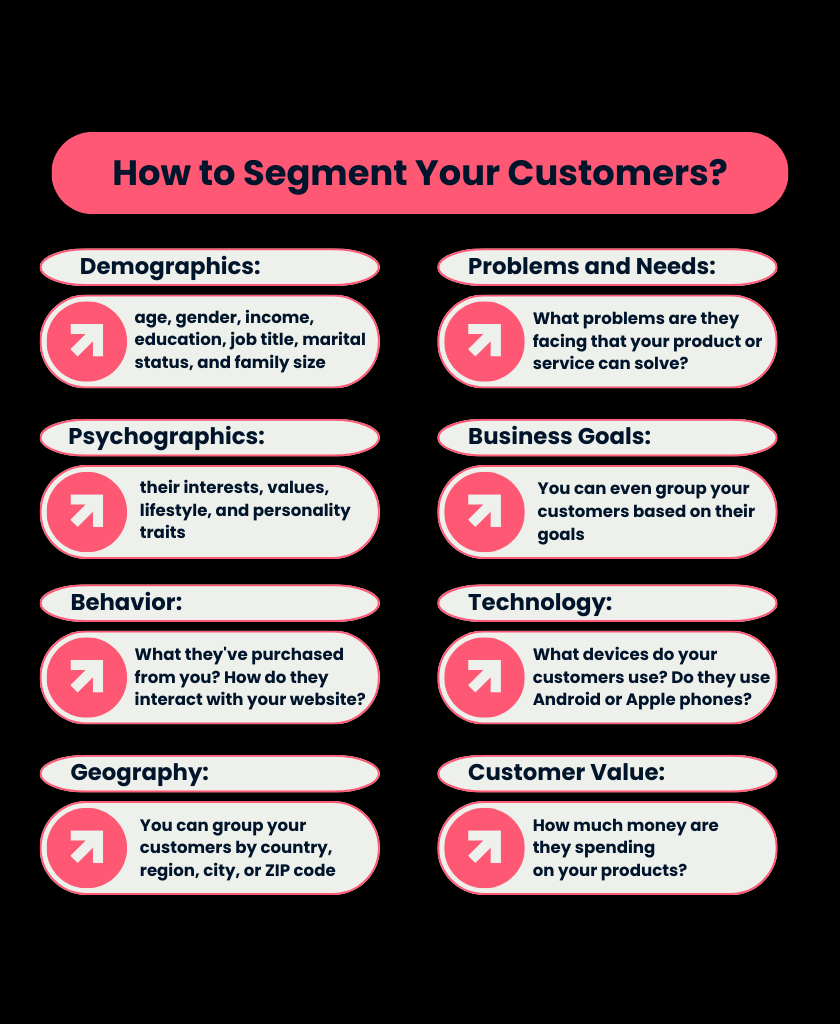
The key here is to use these factors to align your product features with the right customer groups to achieve both customers and your goals.
You have many options, but you don’t have to use them all. That’s because you did your market research and know which factors apply to your target group.
Right?
Analyze Your Competition and Differentiate Your Product
So, we’re talking about checking out the competition and making your products stand out, right?
Here’s the deal: nowadays, it feels like there’s way too much of everything. Only a few markets aren’t super crowded. Most are like a battleground, with competitors all vying for the same customers.
Especially in the tech world, if you’ve got a SaaS (Software as a Service) company, things are super intense. Technology is moving fast and copying software features. Easier than ever. So, you’re stuck in this never-ending race to stay ahead.
This means you must constantly monitor what your rivals are up to – like daily check-ins. It’s all about knowing who’s who in the zoo. Who’s leading the pack? Who’s the underdog trying to shake things up?
And then, there’s the big challenge: setting yourself apart. It’s not just about being different; it’s about being smartly different. You have to figure out what makes you unique and play that up.
Maybe it’s your killer customer service, some unique feature nobody else has, or you’re the budget-friendly option. Whatever it is, it’s gotta be something that makes customers say, „Yeah, these guys, not the others.”
It’s a tough game, but getting this right can put you on the map.
Product Positioning and Messaging? Must be Compelling
So, we’re diving into how to make your product messages pop.
First up, positioning.
What’s that?
It’s how you want people to see your products and services. You’re creating a specific image in their minds that fits your brand.
Imagine you’re making bathroom stuff for small apartments, and it’s pretty affordable. You wouldn’t want to show off big, fancy bathrooms in your ads. If you do, people might think your stuff is too pricey without checking the price tag.
Now, your product messaging and how you showcase and talk about your product have to match up with this positioning. It’s where the branding and the product marketing shake hands. You do this by highlighting the values and benefits of what you’re selling.
Let’s break it down.
Value is about what your product does – the nifty features that make it worth having. For instance, if you’re selling a smartphone, its value could be a super-clear camera. It’s the practical stuff that your product brings to the table.
But then there’s the benefit, which is more about the outcomes or the good stuff from those features.
Like with our smartphone, the benefit of that incredible camera is that you can snap amazing, high-quality photos super easily.
Benefits are all about the feel-good or problem-solving aspects that improve someone’s life.
In short, value is about what your product’s got, and benefits are about how it makes life better.
It’s like saying, „Here’s our cool thing, and here’s why you’ll love it.”
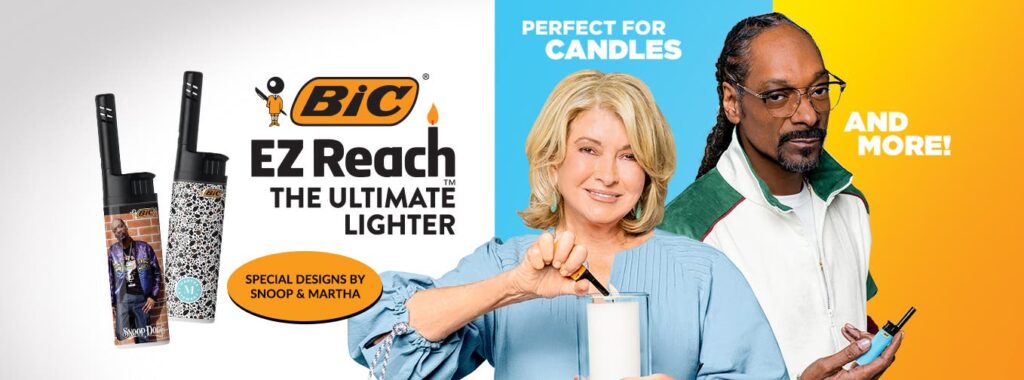
This is super important in marketing because while the values catch the eyes, the benefits tug at hearts and make people want to buy.
Now, check out Carhartt, the clothing brand. They’re known for tough, long-lasting clothes.
Their value? Super durable, can-handle-anything gear.
And the benefit? You don’t have to worry about your clothes when you’re working hard or enjoying outdoor activities.
You can just focus on what you’re doing. They even expanded their brand to outdoor leisure so your family can enjoy the fun, all rugged-in durable gear.
Cool, right?
Time to Develop Your Pricing and Distribution Strategies for Product Success
Pricing and delivery are two other important things to think about when marketing your product. You need to figure out how much to charge your customers and how they want to buy and receive your product.
You might think that the lower you price your product, the better. After all, your offer will be cheaper than what your competitors are selling. You can’t wait for seasonal sales to come up with creative and funny names for discounts and coupon codes for Black Friday, like „Enjoy amazing deals on everything you need with the code BARGAINBONANZA!!!”
But:
- What if your customers don’t trust cheap products?
- What if they’re worried about the quality and think they’ll have to sacrifice their time and image for a bargain?
- What if your customers want to show off their spending power and buy expensive things?
Yes, your pricing needs to be in line with your brand and how you want to be seen.
Volkswagen learned a hard lesson when they tried to sell the Phaeton, a six-figure luxury limousine, under a brand that’s always been seen as affordable „people’s cars.”
They own the Audi and Porsche brands, but despite that, they decided to launch the expensive and luxurious version of Volkswagen, and it failed.
People don’t want to pay a lot for something they view as cheap and affordable. That’s obvious. But on the other hand, if a luxury product is sold cheaply, people may not trust that it’s genuine.
Watch this YouTube video and read the comments. They’re real customer insights you get for free. Yes, I’m encouraging you to do the research.
More examples? Here you go!
Here’s an example of masterful brand and product management by IKEA. The brand is renowned for its affordable home furniture and equipment worldwide.
Luxury apparel is certainly not their category.
But who says they can’t troll a luxury clothing brand like Balenciaga to emphasize their positioning?
Balenciaga recently introduced a beige, unisex towel skirt for a staggering $925.
IKEA responded by reminding us that a towel is just a towel, one of the many practical and affordable items you’ll find in their stores.
And their price tag for a towel? Just £16.
IKEA’s lighthearted trolling not only highlights the absurdity of Balenciaga’s overpriced towel skirt but also reinforces IKEA’s own brand image as a provider of affordable and practical home goods.
By poking fun at Balenciaga’s extravagance, IKEA reminds consumers of their own commitment to value and affordability.
This clever marketing tactic demonstrates IKEA’s understanding of its target audience and its ability to connect with them on a personal level.
IKEA knows that its customers appreciate humor and value, and they’ve used this to their advantage.

Product distribution
I’m not an expert on product distribution, but here are a few things you need to consider:
- Product type: Some products, like ebooks, clothes, and games, are better suited for online sales. Others, like food, furniture, and haircuts, are better suited for offline sales. And some, like phones, makeup, and books, can be sold both online and offline.
- Customer preferences: What do your customers want and expect? Do some research to find out their shopping habits and needs. Then, choose a delivery method that matches what they want.
- Budget: How much does it cost to use different delivery methods? How much money can they make you? Compare the pros and cons of each method and choose the one that gives you the best value for your money. Also, consider the risks and challenges of each method and how you’ll handle them.
- Costs: How much does it cost to make and deliver your product? Include all expenses, like materials, labor, taxes, and fees. You need to charge more than your costs to make a profit.
- Competitors: How much do your competitors charge for similar products? Do some research to find out their prices and value offers. Then, set a price that’s competitive and makes you stand out.
- Value offer: What value does your product offer customers? What makes it unique and special? Communicate this to your customers and charge them based on the value you provide.
Voice of customers & Metrics
But how do you know if your product and brand marketing efforts work?
How do you measure their impact on sales to your target audience?
It’s not easy to show that your product marketing activities directly affect sales, and it’s even harder to do the same for brand marketing.
In fact, you’ll never find 100% proof.
Sure, plenty of business and marketing metrics are out there, but most of them only show how your actions affect sales indirectly or how well your marketing materials performed.
The specific metrics you choose will depend on your business type and your current goals. It’s important to choose metrics that are relevant to your business, and that will give you insights into whether your marketing efforts are working.
If you want to check on the results of your product launch, you can use metrics like:
- Number of leads, free trials, and product demos: This metric measures how many people are interested in your product and are willing to learn more about it.
- New sales and upgrades to the new product version: This metric measures how many people are actually buying your product and whether they’re upgrading to more recent versions.
- Product page views, video tutorial views, and view time: This metric measures how much engagement your product generates and whether people are interested in learning more about it.
- Media mentions and sentiment of reactions: This metric measures how much press your product is getting and whether people are reacting positively to it.
- Product usage or adoption of a new feature: This metric measures how actively people use your product and whether they take advantage of new features.
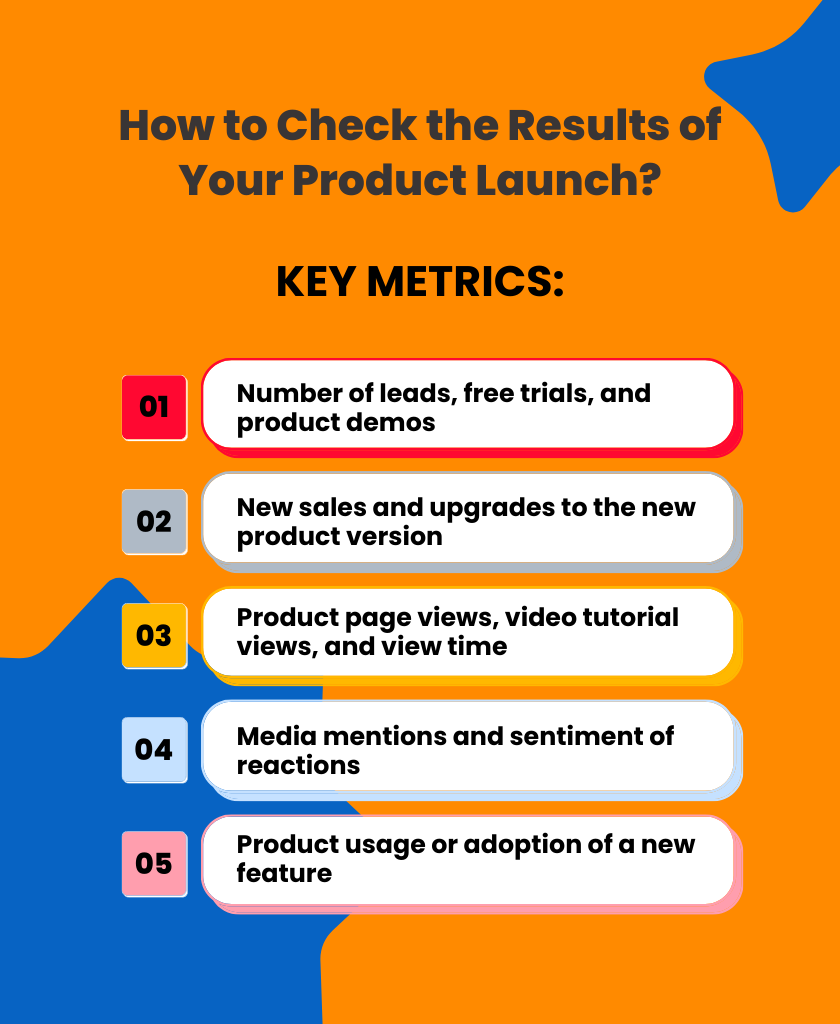
Customer sentiment is another essential metric to consider. This is how customers feel and think about your product based on feedback, such as reviews, ratings, comments, or surveys.
Customer sentiment shows how your customers perceive and feel about your product and their issues and ideas.
I will give you another example from a brilliant company. Imagine if your company was Larian Studios. You’d only need to worry about customer sentiment and sales, nothing else. Just picture it: your game gets top ratings, and your bigger, richer competitors grumble that you’re upsetting the market. That’s when you know you’ve nailed your product marketing.
Larian Studios is making waves with their AAA game publishing, especially with Baldur’s Gate. They launched the game smoothly, without any vast bugs, and presented a complete, well-thought-out package from start to finish – without those pesky microtransactions. That’s like a breath of fresh air in today’s AAA game scene.
But, of course, this has ruffled some feathers in the industry. Other developers and studios think Larian’s success pushes the bar higher for AAA games, making it challenging for others to keep up. The CEO of Larian Studios had a sharp comeback to these concerns about 'Raised Standards.’ He said, „Standards Die Every Day.”
It’s worth mentioning that Larian Studios didn’t just pop up overnight. They’ve been around for nearly 30 years, facing and overcoming many challenges. Their success with Baldur’s Gate 3 is a testament to their dedication to quality and the player experience.
Now it’s your move
This was a heck of a ride!
Brand marketing and product marketing are equally crucial in terms of your company’s bottom line!
As I explained in this article, they have different dynamics. But — those two areas cannot be separated from each other.
They both deserve special attention, long-term investment, and mutual alignment.
—
Have you enjoyed this piece? Please drop us a comment, share it on social, and dive into other guides on our blog!
🌶️
